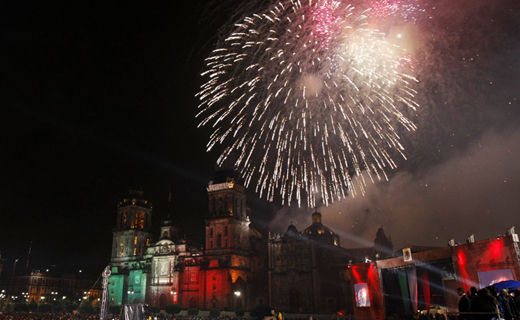
Mexico celebrates its independence from Spain on this date in 1810. For decades, especially since the United States won its independence from England, Mexicans resented Spanish rule. Spain limited Mexican trade, and Spanish subjects born in Mexico (criollos, or Creoles) were denied access to higher positions in the colony.
Napoleon invaded Spain in 1808 and imprisoned King Ferdinand VII. In various parts of Latin America, rebels established their own governments while remaining loyal to the king.
The Grito de Dolores (“Cry of Dolores”) was uttered at the small town of Dolores, near Guanajuato, on September 16, 1810. It is the event that marks the beginning of the 11-year Mexican War of Independence. The “grito” was spoken by Miguel Hidalgo y Costilla, a Roman Catholic priest. Since1825, the anniversary of the event is celebrated as Mexican Independence Day.
Already some organized revolts had taken place, but the plotters were arrested, and later freed from jail by rebel troops. Around 6:00 am on September 16, 1810, Hidalgo ordered the church bells to be rung and gathered his congregation. He addressed the people and encouraged them to revolt.
No scholarly consensus exists as to what exactly Hidalgo said on September 16, 1810. The Course of Mexican History states that in essence Hidalgo said something like this:
“My children: A new dispensation comes to us today. Will you receive it? Will you free yourselves? Will you recover the lands stolen 300 years ago from your forefathers by the hated Spaniards? We must act at once…. Will you defend your religion and your rights as true patriots? Long live Our Lady of Guadalupe! Death to bad government! Death to the gachupines(native Spaniards)!”
Thousands of Indians and mestizos flocked to Hidalgo’s banner of the Virgin of Guadalupe, and soon the peasant army was on the march to Mexico City.Defeated at Calderón in January 1811, Hidalgo fled north but was captured and executed. He was followed by other peasant leaders, however, such as José María Morelos y Pavón, Mariano Matamoros, and Vicente Guerrero, who all led armies of revolutionaries against the Spanish and the Royalists.
Ironically, it was the Royalists, made up of Mexicans of Spanish descent and other conservatives, who ultimately brought about independence. In 1820, liberals took power in Spain, and the new government promised reforms to appease the Mexican revolutionaries. In response, Mexican conservatives called for independence as a means of maintaining their privileged position.
In early 1821, Agustín de Iturbide, leader of the Royalist forces, negotiated the Plan of Iguala with Vicente Guerrero. Under its terms, Mexico would become an independent constitutional monarchy, the privileged role of the Catholic Church would be maintained, and Mexicans of Spanish descent would be regarded as equal to pure Spaniards. Mexicans of mixed or pure Indian blood would have lesser rights.
Iturbide defeated the Royalist forces still opposed to independence, and the new Spanish viceroy, lacking money, provisions and troops, was forced to accept Mexican independence. On August 24, 1821, Spanish Viceroy Juan de O’Donojú signed the Treaty of Córdoba, making Mexico an independent constitutional monarchy. In 1822, as no Bourbon monarch to rule Mexico had been found, Iturbide was proclaimed the emperor of Mexico. However, his empire was short-lived, and in 1823 republican leaders Santa Anna and Guadalupe Victoria deposed Iturbide and set up a republic, with Guadalupe Victoria as its first president.
Each year on the night of September 15, at around eleven in the evening, the President of Mexico rings the bell of the National Palace in Mexico City. He then repeats a shout of patriotism (a grito mexicano) based upon the Grito de Dolores, with the names of the important heroes of the Mexican War of Independence, and three shouts of ¡Viva México! to the assembled crowd from the balcony over the Zócalo, one of the largest public plazas in the world. Flags are waved and the national anthem is played, in an event that draws up to half a million spectators.
On the morning of September 16, or Independence Day, the national military parade takes place. A similar celebration occurs in cities and towns all over Mexico, and in Mexican embassies and consulates worldwide on the 15th or the 16th.
Adapted from latinamericanhistory.about.com, Wikipedia, and This Day in History.
Photo: Fireworks explode in Mexico City in celebration of Mexican Independence Day. | Gregory Bull/AP












Comments